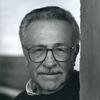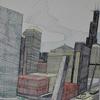Dia Presents Andy Warhol’s Shadows
- NEW YORK, New York
- /
- November 06, 2018
Shadows (1978–79) is on view at the ground-level gallery space at Calvin Klein, Inc.’s headquarters, located at 205 West 39th Street. The work is being shown in New York City to coincide with the artist’s retrospective at the Whitney Museum of American Art, before being reinstalled on long-term view at Dia:Beacon in 2019.
Andy Warhol’s Shadows (1978–79) returns to New York City this October, marking a homecoming for the monumental work that was first presented by Dia in the city in 1979.
A single painting in multiple parts, Shadows is one of Warhol’s most abstract works, yet one that cohesively synthesizes key elements of his practice, including film, painting, photography, and screenprinting.
On view through December 15, 2018, at 205 West 39th Street, a street-front space in Calvin Klein, Inc.’s headquarters, the installation surrounds the viewer with a series of canvases, presented edge-to-edge around the perimeter of the room in conformity with Warhol’s original vision.
Following its New York presentation, the work will reopen as a long-term installation at Dia:Beacon in Beacon, New York, in 2019. Exhibited concurrently with the retrospective Andy Warhol — From A to B and Back Again at the Whitney Museum of American Art, Shadows will be animated by a series of public programs and a publication of essays by contemporary artists on Warhol, the third book in Dia’s Artists on Artists Lecture Series.
Shadows, which recently completed an extensive international tour, has not been exhibited in New York City since 1998–99, when Dia presented it in its former Chelsea location. The presentation and conservation of the work have been made possible by CALVIN KLEIN.
“Andy Warhol was among the original group of artists championed by Dia in the 1970s, and the depth and duration of the relationship lead to Dia’s acquisition of over two hundred works by the artist as well as the eventual gift in the 1990s of the majority of these works for the creation of the Andy Warhol Museum in Pittsburgh. One of Warhol’s most enigmatic works, Shadows became an iconic part of Dia’s collection when it was first shown in 1979.
The presentation of this work provides a rare opportunity to fully appreciate the remarkable use of seriality and difference in his practice,” said Jessica Morgan, Dia’s Nathalie de Gunzburg Director. “This exhibition marks the first time in twenty years that visitors will be able to experience the work in New York City, where it made its debut, before it returns to Dia:Beacon. Placed within the broader context of Dia’s programming and the creative continuum of Warhol’s work on view at the Whitney, we hope this presentation will shed new light on one of the artist’s most complex and remarkable works.”
“Shadows is a Warholian tour de force, an unexpected culmination of many of the experiments that Warhol pursued throughout his career, from his first explorations of photography in the 1950s, to his engagement with light, shadow, and abstraction in the 1970s,” said Donna De Salvo, the Whitney’s Deputy Director for International Initiatives and Senior Curator, who served as a curator at Dia from 1981 to 1986. “Dia’s artist-driven collection was where I was first able to really immerse myself in Warhol’s work and where I first met Warhol directly. Dia’s decision to present Shadows concurrently with the retrospective at the Whitney adds crucially to our effort to provide a holistic view of Warhol’s oeuvre and offers the public an unprecedented opportunity to map Warhol’s trajectory and to experience the significance of seriality in his work.”
In 1978, at fifty years old , Warhol embarked upon the production of Shadows with the assistance of his entourage at the Factory. The commissioned body of work was acquired by Dia in 1979 (then the Lone Star Foundation) for a solo exhibition at 393 West Broadway.
Beginning with photographs of maquettes expressly created to form shadows, Warhol produced a large number of silkscreens balanced between “the peak” (a tall, narrow form) and “the cap” (a shorter, more organic form). The peak appears almost exclusively in black (with two exceptions in silver) against a background of colors characteristic of Warhol’s larger body of work—the translucent violet of Lavender Disaster (1963) or the aqua green of Turquoise Marilyn (1964). The cap appears as a negative on the black background, itself taking on the hues of Warhol’s signature vocabulary.
The radical implications of Shadows begin with its form. Composed of 102 screenprints, the final number of canvases in each installation is determined by the dimensions of an existing exhibition space. The canvases are installed edge to edge, a foot above the floor, in the order that Warhol’s assistants Ronnie Cutrone and Stephen Mueller originally hung them.
The installation parameters thus mimic the continuity of a filmstrip and reference the artist’s significant film making practice as well as create an immersive experience for viewers.
Despite outsourcing these decisions to his assistants, the artist’s method was far from arbitrary. By restricting himself to two motifs, a limited number of hues, and only two colors per canvas, Warhol filtered control through the serendipity of taste to create an environmental ensemble that pertains as much to “disco décor,” as he described the work in 1979, as it does to high art.
















